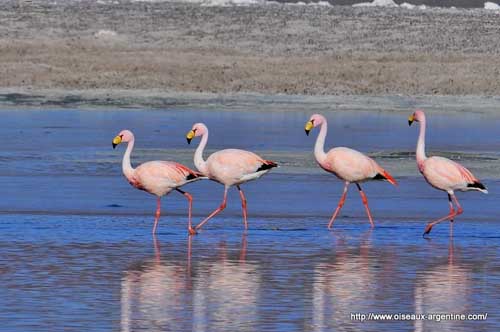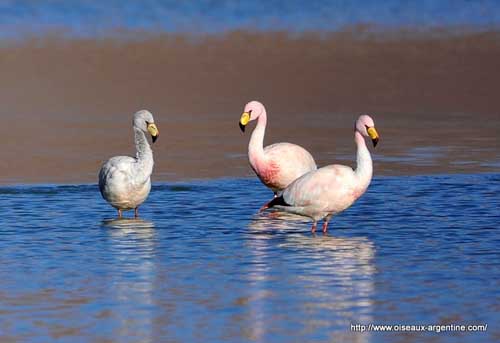
James’s Flamingo or Puna Flamingo
Phoenicoparrus jamesi
Ordre des Phoenicoptériformes – Famille des Phoenicoptéridés
BIOMETRICS:
Length: 90-92 cm
Weight: 2000 g
DESCRIPTION:
The James’s Flamingo also named Puna Flamingo, is the palest and the smallest of the South American flamingos, the Chilean Flamingo and the Andean Flamingo.
It is named for the English naturalist Henry Berkeley James, who found this new species in Chile.
The adult has pale pink plumage with bright carmine streaks on breast and back in breeding plumage, and bright red elongated scapular feathers. The flight feathers are black, whereas other flamingos have red ones, except the Andean Flamingo which belongs to the same genus Phoenicoparrus.
Belly and undertail-coverts are white. The axillaries are orange-pink.
Head and upperneck are darker pink. The typical bill is bright orange-yellow with black tip which is relatively short compared to other species. The bare skin of the face is red. The eyes are dark orange-red. The long legs and the feet are deep red. The feet lack the hind toe.
Outside the breeding season, the carmine streaks on breast are less conspicuous.
Male and female have similar plumage.
The immature is pale greyish with fine blackish streaks on the upperparts.
Fr: Flamant de James
All : Jamesflamingo
Esp (Argentine, Chili, Bolivie) : Parina Chica
Ital : Fenicottero di James
Nd : James-flamingo
Sd : Punaflamingo
Photographers:
Philippe and Aline Wolfer
OISEAUX D'ARGENTINE
Text by Nicole Bouglouan
Sources:
HANDBOOK OF THE BIRDS OF THE WORLD vol 1 by Josep del Hoyo-Andrew Elliot-Jordi Sargatal - Lynx Edicions - ISBN: 8487334105
BirdLife International (BirdLife International)
Wikipedia, the free encyclopaedia
The Cornell Lab of Ornithology – Neotropical birds

VOICE: SOUNDS BY XENO-CANTO
The James’s Flamingo is noisy when in flocks where the voice becomes important for mutual recognition between parents and chicks. Several calls can be heard, from low gabbling sounds of the feeding flock to nasal honking calls when in flight.
During courtship and aggressive displays, a deep grunting or growling is produced at the colony. The voice usually plays an important part in the ritualized displays, and each movement and posture is accompanied with different particular sounds.
HABITAT:
The James’s Flamingo frequents the salt-lakes at high elevation of the Andean “altiplano”, usually above 3500 metres, and only lakes with soft substrate bottom.
It breeds on islands or islets along the shores or in centre of these salt-lakes.
RANGE:
The James’s Flamingo has restricted range in the Andes, from S Peru, W Bolivia, N Chile and NW Argentina.
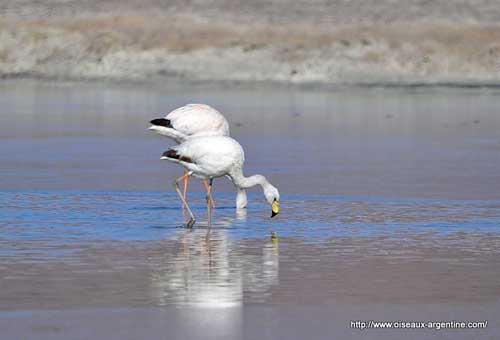
BEHAVIOUR:
The James’s Flamingo feeds in water by walking slowly or even swimming with several pauses. This species has shorter bill than other flamingos, and the filtering area is fairly small too. This area is full of long and fine hairs, very useful for filtering the water.
It feeds on minute plankton of family Bacillariophyceae, which are unicellular planktonic micro algae of less than 0, 6 mm long. The foraging flock is loose and the birds are widely scattered over the lake.
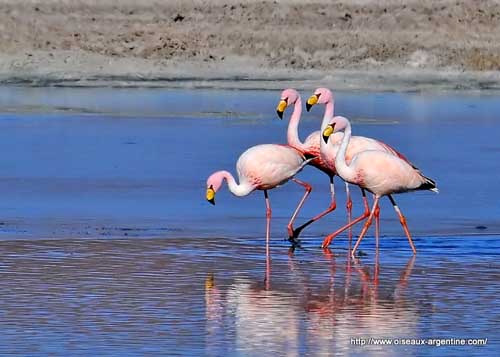
The James’s Flamingo of the Andean altiplano breeds at the beginning of the rainy season, usually from late November. They breed in large colonies, sometimes with Chilean Flamingos and Andean Flamingos, without segregation between them.
The courtship behaviour often starts some months before breeding. The flamingos usually perform collective displays with series of ritualized postures and movements.
The most common is the “head-flagging” during which each bird stretches its neck and raises the head as high as possible with the bill pointed upwards. Then, all the flamingos turn the head from side to side. These displays are accompanied with continuous loud calls.
The second posture is called “wing-salute”. The flamingos spread the wings for a few seconds to display the contrasted colours. The tail is cocked and the neck outstretched. These displays are accompanied with low grunts.
The “marching” display is performed by the large, tightly packed and synchronized flock. The birds walk in one direction before turning tail abruptly.
The pair-bonds are formed during these displays.
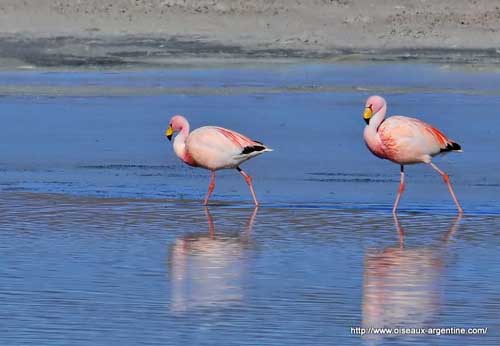
As other flamingos, the James’s Flamingo spends most of the time in feeding, preening and resting. Their plumage needs regular cleaning with the accumulation of salt on their feathers.
The feeding behaviour decreases when the courtship displays reach their peak and during the nesting period. This fact indicates that flamingos probably store up nutrient reserves before the breeding activities.
The movements of the James’s Flamingo are poorly known. They probably perform altitudinal movements in late summer to reach other salt-lakes at lower elevation. But some birds may remain on the breeding grounds during winter, because the water does not freeze, due to hot volcanic springs.
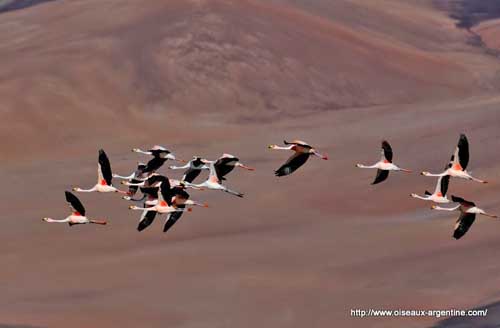
FLIGHT:
The James’s Flamingo has to run a few steps while flapping the wings in order to take off and it alights in the same way. It flies with the neck outstretched, and performs fast and direct flight. It may reach speeds of 50-60 km/hour. It performs rapid wingbeats, sometimes interspersed with short glides.
When in flocks, they usually fly in V formation.
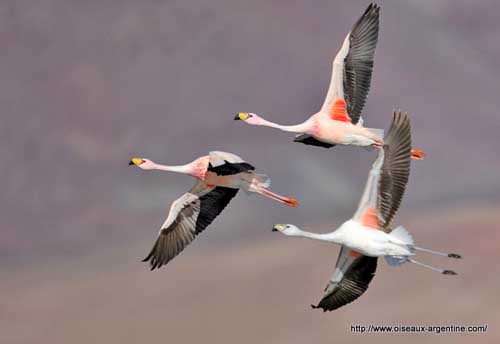
REPRODUCTION:
The breeding season begins in late November with laying between December and February.
The James’s Flamingo nests in large colonies often mixed with the other South American flamingo species. They are probably monogamous with strong pair-bonds. The copulation occurs after the pair has left the displaying flocks, and can take place at different sites, away from the breeding grounds.
Both parents build the nest, a truncated cone made with mud, with a shallow depression on top. They use their bills to work the mud, and may add stones and plant debris if available. The building often continues once the egg is laid, to heighten the nest.
The female lays a single white egg and the incubation starts immediately, shared by both parents. This period lasts about 27 to 31 days. At hatching, the chick is covered with grey down. Both adults brood it during 5-12 days. They feed the chick with milk (like pigeons) secreted in the upper digestive tract. This milk is produced by both sexes.
When the young leaves the nest, it is able to walk and to swim fairly well. It joins other chicks in large crèches with numerous other young birds, looked after by some adults. Their parents regularly feed the chicks, thanks to the voice which allows mutual recognition.
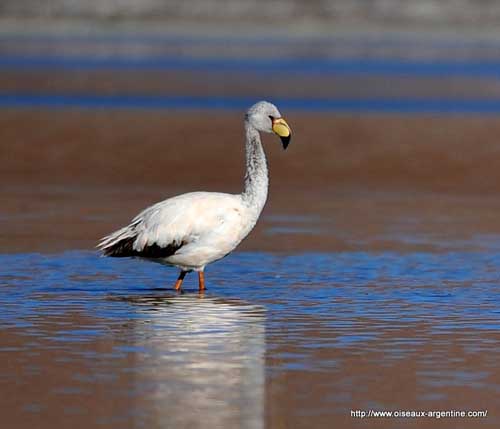
DIET:
The James’s Flamingo feeds on minute plankton of family Bacillariophyceae, which are unicellular microalgae of less than 0, 6 mm. The water is filtered with the bill.
PROTECTION /THREATS / STATUS:
The James’s Flamingo is currently considered “Near Threatened”, due to egg harvesting and hunting in the 20th century, and degradation and habitat loss. Pollution and diversion of streams by humans have been the main threats.
However, some signs of recovery have been reported, and the classification has been upgraded from “Vulnerable” to “Near Threatened” in 2004.
